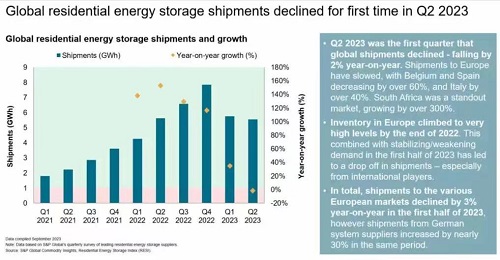Global residential battery energy storage system shipments fell year-on-year for the first time in the second quarter of 2023.
A research report recently released by S&P Global pointed out that against the background of low energy price fluctuations, high inventories and rising costs, the year-on-year shipment of global residential energy storage system declined for the first time in the second quarter of 2023.

S&P Global Residential Battery Energy Storage System Shipments Chart for Q2, 2023
German up 30%, Global down 2%
According to the data, although the German energy storage market continues to maintain strong growth momentum (up 30% in the first half of this year, while the European energy storage market fell by 3%), overall global battery energy storage system shipments fell by 2% year-on-year to about 5.5GWh, especially the growth rate of the European market has slowed down.
It is reported that the biggest driving factors for the decline in demand for energy storage systems in Europe in 2023 are the normalization of energy prices and high inventory levels in Europe after strong demand in 2022.
The biggest factor driving this trend is that electricity prices are already starting to fall after rising sharply in 2022 amid the energy crisis. Italy has also reduced government subsidies, while high interest rates and economic uncertainty are also reducing consumer spending.
Residential ESS
Residential energy storage systems are often deployed in conjunction with residential solar power systems to increase energy self-sufficiency and protect households from the effects of high or unstable energy prices. They can also serve as part of demand response programs, incentivizing consumers to draw less power from the grid during peak periods.
Global residential energy storage system shipments also declined sequentially in Q1 of this year, but may be affected by some seasonal factors. However, starting from Q1 2021, growth has occurred in the first eight quarters.
How different factors contributed to the decline ?
In 2022, residential energy storage system shipments surged in response to the energy crisis as consumers turned to self-consumption of electricity to combat high electricity bills.
As energy storage system distributors scramble to place orders in 2022 to meet surging market demand and avoid long expected delivery times for imported products, which has led to oversupply.
Meanwhile, with falling market demand in Q1 2023, residential energy storage system inventory had reached to high level at the end of 2022.
Future prospects
Installed capacity of residential energy storage systems in mature markets such as Germany will continue to grow, driven by a strong residential PV market and supportive subsidies.
Emerging markets in Southern and Eastern Europe, including Poland, Greece and the Czech Republic, are also seeing rising demand for battery storage due to attractive subsidies and mature PV markets.
However, short-term constraints come from consumer spending, while long-term growth will be driven by retrofits of existing solar power systems and increasing advances in sophisticated home energy management systems, including EV charging, heat pumps and virtual power plants.



